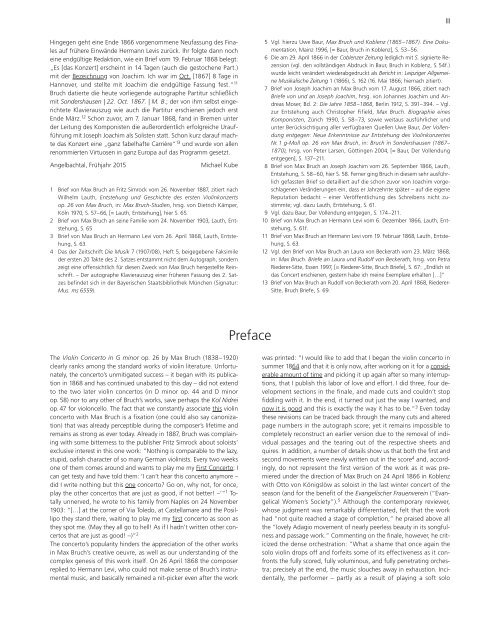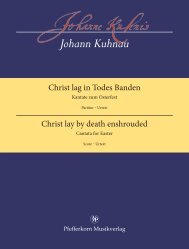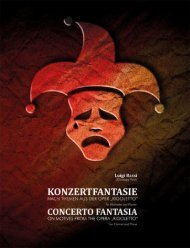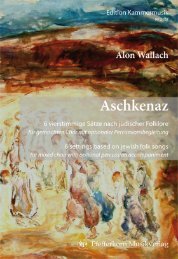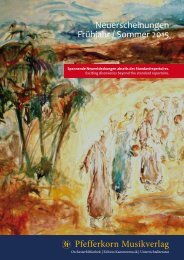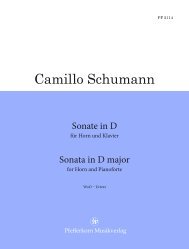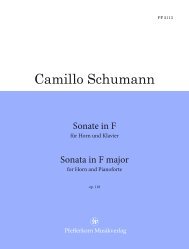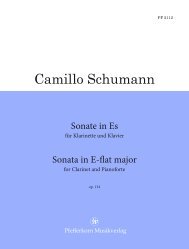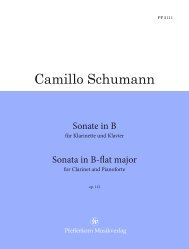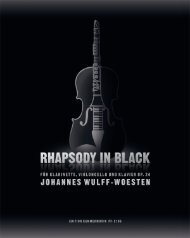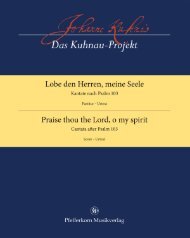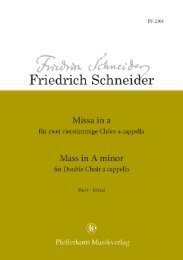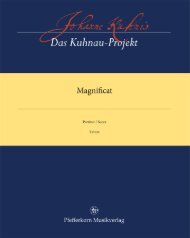Max Bruch - Violinkonzert Nr. 1 g-moll op. 26
Bruch, Violinkonzert, Breitkopf, Partitur-Bibliothek
Bruch, Violinkonzert, Breitkopf, Partitur-Bibliothek
Sie wollen auch ein ePaper? Erhöhen Sie die Reichweite Ihrer Titel.
YUMPU macht aus Druck-PDFs automatisch weboptimierte ePaper, die Google liebt.
III<br />
Hingegen geht eine Ende 1866 vorgenommene Neufassung des Finales<br />
auf frühere Einwände Hermann Levis zurück. Ihr folgte dann noch<br />
eine endgültige Redaktion, wie ein Brief vom 19. Februar 1868 belegt:<br />
„Es [das Konzert] erscheint in 14 Tagen (auch die gestochene Part.)<br />
mit der Bezeichnung von Joachim. Ich war im Oct. [1867] 8 Tage in<br />
Hannover, und stellte mit Joachim die endgültige Fassung fest.“ 11<br />
<strong>Bruch</strong> datierte die heute vorliegende autographe Partitur schließlich<br />
mit Sondershausen | 22. Oct. 1867. | M. B.; der von ihm selbst eingerichtete<br />
Klavierauszug wie auch die Partitur erschienen jedoch erst<br />
Ende März. 12 Schon zuvor, am 7. Januar 1868, fand in Bremen unter<br />
der Leitung des Komponisten die außerordentlich erfolgreiche Uraufführung<br />
mit Joseph Joachim als Solisten statt. Schon kurz darauf machte<br />
das Konzert eine „ganz fabelhafte Carrière“ 13 und wurde von allen<br />
renommierten Virtuosen in ganz Eur<strong>op</strong>a auf das Programm gesetzt.<br />
Angelbachtal, Frühjahr 2015<br />
Michael Kube<br />
1 Brief von <strong>Max</strong> <strong>Bruch</strong> an Fritz Simrock vom <strong>26</strong>. November 1887, zitiert nach<br />
Wilhelm Lauth, Entstehung und Geschichte des ersten <strong>Violinkonzert</strong>s<br />
<strong>op</strong>. <strong>26</strong> von <strong>Max</strong> <strong>Bruch</strong>, in: <strong>Max</strong> <strong>Bruch</strong>-Studien, hrsg. von Dietrich Kämper,<br />
Köln 1970, S. 57–66, [= Lauth, Entstehung], hier S. 65.<br />
2 Brief von <strong>Max</strong> <strong>Bruch</strong> an seine Familie vom 24. November 1903, Lauth, Entstehung,<br />
S. 65<br />
3 Brief von <strong>Max</strong> <strong>Bruch</strong> an Hermann Levi vom <strong>26</strong>. April 1868, Lauth, Entstehung,<br />
S. 63.<br />
4 Das der Zeitschrift Die Musik 7 (1907/08), Heft 5, beigegebene Faksimile<br />
der ersten 20 Takte des 2. Satzes entstammt nicht dem Autograph, sondern<br />
zeigt eine offensichtlich für diesen Zweck von <strong>Max</strong> <strong>Bruch</strong> hergestellte Reinschrift.<br />
– Der autographe Klavierauszug einer früheren Fassung des 2. Satzes<br />
befindet sich in der Bayerischen Staatsbibliothek München (Signatur:<br />
Mus. ms 6559).<br />
5 Vgl. hierzu Uwe Baur, <strong>Max</strong> <strong>Bruch</strong> und Koblenz (1865–1867). Eine Dokumentation,<br />
Mainz 1996, [= Baur, <strong>Bruch</strong> in Koblenz], S. 53–56.<br />
6 Die am 29. April 1866 in der Coblenzer Zeitung lediglich mit S. signierte Rezension<br />
(vgl. den vollständigen Abdruck in Baur, <strong>Bruch</strong> in Koblenz, S. 54f.)<br />
wurde leicht verändert wiederabgedruckt als Bericht in: Leipziger Allgemeine<br />
Musikalische Zeitung 1 (1866), S. 162 (16. Mai 1866; hiernach zitiert).<br />
7 Brief von Joseph Joachim an <strong>Max</strong> <strong>Bruch</strong> vom 17. August 1866, zitiert nach<br />
Briefe von und an Joseph Joachim, hrsg. von Johannes Joachim und Andreas<br />
Moser, Bd. 2: Die Jahre 1858–1868, Berlin 1912, S. 391–394. – Vgl.<br />
zur Entstehung auch Christ<strong>op</strong>her Fifield, <strong>Max</strong> <strong>Bruch</strong>. Biographie eines<br />
Komponisten, Zürich 1990, S. 58–73, sowie weitaus ausführlicher und<br />
unter Berücksichtigung aller verfügbaren Quellen Uwe Baur, Der Vollendung<br />
entgegen: Neue Erkenntnisse zur Entstehung des <strong>Violinkonzert</strong>es<br />
<strong>Nr</strong>.1 g-Moll <strong>op</strong>. <strong>26</strong> von <strong>Max</strong> <strong>Bruch</strong>, in: <strong>Bruch</strong> in Sondershausen (1867–<br />
1870), hrsg. von Peter Larsen, Göttingen 2004, [= Baur, Der Vollendung<br />
entgegen], S. 137–211.<br />
8 Brief von <strong>Max</strong> <strong>Bruch</strong> an Joseph Joachim vom <strong>26</strong>. September 1866, Lauth,<br />
Entstehung, S. 58–60, hier S. 58. Ferner ging <strong>Bruch</strong> in diesem sehr ausführlich<br />
gefassten Brief so detailliert auf die schon zuvor von Joachim vorgeschlagenen<br />
Veränderungen ein, dass er Jahrzehnte später – auf die eigene<br />
Reputation bedacht – einer Veröffentlichung des Schreibens nicht zustimmte;<br />
vgl. dazu Lauth, Entstehung, S. 61.<br />
9 Vgl. dazu Baur, Der Vollendung entgegen, S. 174–211.<br />
10 Brief von <strong>Max</strong> <strong>Bruch</strong> an Hermann Levi vom 6. Dezember 1866, Lauth, Entstehung,<br />
S. 61f.<br />
11 Brief von <strong>Max</strong> <strong>Bruch</strong> an Hermann Levi vom 19. Februar 1868, Lauth, Entstehung,<br />
S. 63.<br />
12 Vgl. den Brief von <strong>Max</strong> <strong>Bruch</strong> an Laura von Beckerath vom 23. März 1868,<br />
in: <strong>Max</strong> <strong>Bruch</strong>. Briefe an Laura und Rudolf von Beckerath, hrsg. von Petra<br />
Riederer-Sitte, Essen 1997, [= Riederer-Sitte, <strong>Bruch</strong> Briefe], S. 67: „Endlich ist<br />
das Concert erschienen, gestern habe ich meine Exemplare erhalten […]“<br />
13 Brief von <strong>Max</strong> <strong>Bruch</strong> an Rudolf von Beckerath vom 20. April 1868, Riederer-<br />
Sitte, <strong>Bruch</strong> Briefe, S. 69.<br />
Preface<br />
The Violin Concerto in G minor <strong>op</strong>. <strong>26</strong> by <strong>Max</strong> <strong>Bruch</strong> (1838–1920)<br />
clearly ranks among the standard works of violin literature. Unfortunately,<br />
the concerto’s unmitigated success – it began with its publication<br />
in 1868 and has continued unabated to this day – did not extend<br />
to the two later violin concertos (in D minor <strong>op</strong>. 44 and D minor<br />
<strong>op</strong>. 58) nor to any other of <strong>Bruch</strong>’s works, save perhaps the Kol Nidrei<br />
<strong>op</strong>. 47 for violoncello. The fact that we constantly associate this violin<br />
concerto with <strong>Max</strong> <strong>Bruch</strong> is a fixation (one could also say canonization)<br />
that was already perceptible during the composer’s lifetime and<br />
remains as strong as ever today. Already in 1887, <strong>Bruch</strong> was complaining<br />
with some bitterness to the publisher Fritz Simrock about soloists’<br />
exclusive interest in this one work: “Nothing is comparable to the lazy,<br />
stupid, oafish character of so many German violinists. Every two weeks<br />
one of them comes around and wants to play me my First Concerto; I<br />
can get testy and have told them: ‘I can’t hear this concerto anymore –<br />
did I write nothing but this one concerto? Go on, why not, for once,<br />
play the other concertos that are just as good, if not better! –’” 1 Totally<br />
unnerved, he wrote to his family from Naples on 24 November<br />
1903: “[…] at the corner of Via Toledo, at Castellamare and the Posillipo<br />
they stand there, waiting to play me my first concerto as soon as<br />
they spot me. (May they all go to hell! As if I hadn’t written other concertos<br />
that are just as good! –)” 2<br />
The concerto’s p<strong>op</strong>ularity hinders the appreciation of the other works<br />
in <strong>Max</strong> <strong>Bruch</strong>’s creative oeuvre, as well as our understanding of the<br />
complex genesis of this work itself. On <strong>26</strong> April 1868 the composer<br />
replied to Hermann Levi, who could not make sense of <strong>Bruch</strong>’s instrumental<br />
music, and basically remained a nit-picker even after the work<br />
was printed: “I would like to add that I began the violin concerto in<br />
summer 1864 and that it is only now, after working on it for a considerable<br />
amount of time and picking it up again after so many interruptions,<br />
that I publish this labor of love and effort. I did three, four devel<strong>op</strong>ment<br />
sections in the finale, and made cuts and couldn’t st<strong>op</strong><br />
fiddling with it. In the end, it turned out just the way I wanted, and<br />
now it is good and this is exactly the way it has to be.” 3 Even today<br />
these revisions can be traced back through the many cuts and altered<br />
page numbers in the autograph score; yet it remains impossible to<br />
completely reconstruct an earlier version due to the removal of individual<br />
passages and the tearing out of the respective sheets and<br />
quires. In addition, a number of details show us that both the first and<br />
second movements were newly written out in the score 4 and, accordingly,<br />
do not represent the first version of the work as it was premiered<br />
under the direction of <strong>Max</strong> <strong>Bruch</strong> on 24 April 1866 in Koblenz<br />
with Otto von Königslöw as soloist in the last winter concert of the<br />
season (and for the benefit of the Evangelischer Frauenverein (“Evangelical<br />
Women’s Society”). 5 Although the contemporary reviewer,<br />
whose judgment was remarkably differentiated, felt that the work<br />
had “not quite reached a stage of completion,” he praised above all<br />
the “lovely Adagio movement of nearly peerless beauty in its songfulness<br />
and passage work.” Commenting on the finale, however, he criticized<br />
the dense orchestration: “What a shame that once again the<br />
solo violin dr<strong>op</strong>s off and forfeits some of its effectiveness as it confronts<br />
the fully scored, fully voluminous, and fully penetrating orchestra;<br />
precisely at the end, the music slouches away in exhaustion. Incidentally,<br />
the performer – partly as a result of playing a soft solo


